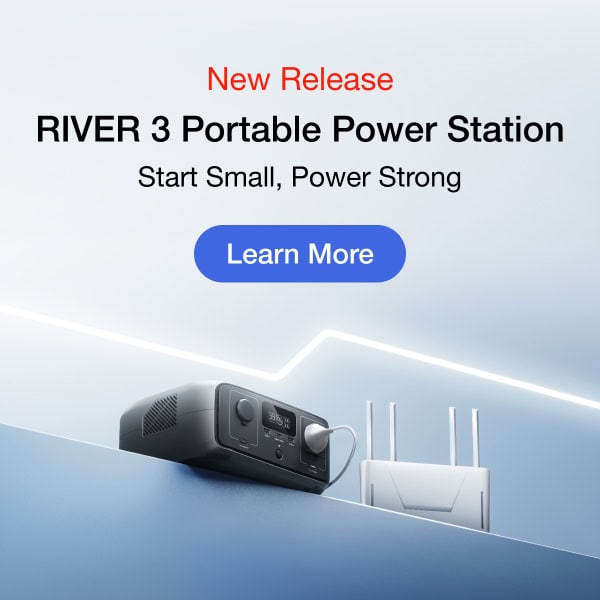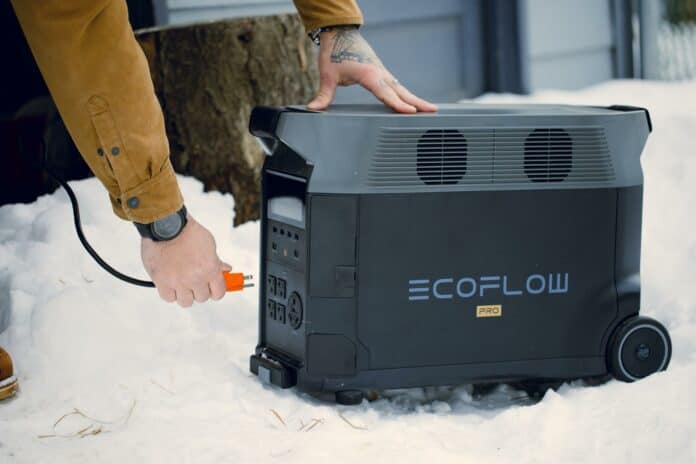Portable power stations and solar generators are affordable, eco-friendly devices that provide off-grid and emergency power. There are many different devices, each with varying battery capacities.
You can narrow your search for a solar generator by determining the required power output and storage capacity. Sizing your ideal system requires a few calculations, including your power requirements, the operating temperature, and the battery type.
Let’s explore these factors and determine how to calculate the battery capacity you’ll need from a solar generator.
What Is Solar Battery Capacity?
Solar battery capacity refers to the amount of electricity that can be stored in a battery storage system. Storage capacity is typically measured in ampere-hours (Ah), watt-hours (Wh), or kilowatt-hours (kWh).
The greater the solar battery capacity, the more electricity it can store. A high-capacity battery is particularly useful for homes that rely on solar power as their primary source of off-grid electricity.
Factors Affecting Battery Capacity of Solar Generators
Size and Type of Battery
The most significant factor that affects storage capacity is the size and type of battery. Size refers to physical dimensions and volume. In general, larger batteries have higher capacity than smaller ones.
Battery chemistry also plays a crucial role in determining capacity. Different types of batteries have different chemistries and characteristics that impact their performance. For example, lithium-ion batteries typically have higher energy density and capacity than lead-acid batteries of the same size. LiFePO4 (LFP) batteries have a longer lifespan and deeper discharge capacity.
Temperature
Temperature can significantly impact battery capacity. Most batteries have an ideal temperature range at which they can function. Operating outside of this range may diminish the capacity.
Lead-acid batteries are highly susceptible to temperature changes and only perform well at room temperature. High and low temperatures cause the reactions in a lead-acid battery to speed up or slow down, respectively. Heat causes it to discharge faster, while cold reduces capacity.
Lithium Iron Phosphate (LiFePO4) and other Li-ion batteries are less affected by extreme temperatures. For example, the batteries in the RIVER 2 series have discharge and storage temperatures of 14°F to 113°F (-10°C to 45°C). The optimal operating temperature is 68°F to 86°F (20°C to 30°C).
Battery Age and Condition
As batteries age, their capacity decreases due to usage, temperature, and storage conditions. Ageing leads to a gradual breakdown of active materials and increased internal resistance. Damaged or faulty batteries may also have reduced capacity or not function at all.
Proper maintenance and usage can extend a battery’s life and capacity. However, all batteries degrade over time.
Types of Solar Generator Batteries
Solar generators may contain any of several types of batteries:
- Lead-Acid Batteries: These are common in solar generators, cars, and other energy storage applications. They are inexpensive and can withstand deep discharges. However, they are heavy, have a low energy density, and require regular maintenance.
- Lithium-Ion Batteries: Li-ion batteries are popular due to their high energy density, low weight, and longer lifespan. They are more expensive than lead-acid batteries but require less maintenance and can be discharged deeper without damaging the battery. LiFePO4 is the preferred type of lithium battery for solar applications such as the EcoFlow Power Kits, which use solar panels to generate and store electricity.
- Nickel-Cadmium Batteries: Ni-Cad batteries have been used in solar generators for many years. They’re durable, have a long lifespan, and can operate in extreme temperatures. However, they have a lower energy density than lithium-ion batteries and contain toxic materials that harm the environment.
Sizing Your Solar Generator: How Big Should It Be?
The solar generator size you require depends on your electricity consumption. To be on the safe side, you should purchase a system with a power output and storage capacity that exceeds your usage.
To determine the system size you need, you should review your monthly electricity bills to determine your average annual consumption.
You can also estimate your consumption by adding up the required wattage of your essential appliances.
Here’s how.
- Identify the wattage requirements of your appliances. Survey the starting and running wattage requirements of the appliances and devices you plan to plug into the generator. You can usually find the wattage requirements labelled on the appliance, but we’ve also compiled the starting and running watts of typical household appliances in the table below.
- Convert volts/amps to watts. If your appliance’s power requirements are in volts or amps, you can calculate an appliance’s running watts with this equation:
Volts (V) x Amps (A) = Watts (W)
- Count the running watts of your appliances. Add up the running watts of the appliances you plan to use — does the total exceed the running watts listed on your generator? If so, you should consider buying a generator with more output capacity.
- Factor in starting watt requirements. Identify the appliance with the highest starting wattage. Add that appliance’s starting wattage to the running wattage total.
- Calculate the sum. That final number is the total starting watts you need from your generator. As discussed above, to avoid overloading your generator, do not exceed its starting watts rating.
Starting and Running Watts of Typical Household Appliances
| Appliance | Rated (Running) Watts | Starting Watts |
| Dishwasher | 1300 | 1800 |
| Washing Machine | 1200 | 2300 |
| Refrigerator/Freezer | 700 | 2200 |
| Light Bulb | 60-75 | 0 |
| Microwave | 600-1000 | 0 |
| TV | 500 | 0 |
| Toaster | 900 | 0 |
| Vacuum | 1440 | 2500 |
| Coffee Maker | 1000 | 0 |
| Blender | 300 | 800 |
| Clothing Iron | 1500 | 0 |
| Dryer | 5400 | 7000 |
| Toaster Oven | 1200 | 0 |
| Curling Iron | 1500 | 0 |
| Space Heater | 2000 | 0 |
| Laptop | 50-300 | 0 |
| 20” Box Fan | 200 | 350 |
The Relationship Between Battery Capacity and Battery Life
As the capacity of a battery decreases, so does its lifespan. As a battery repeatedly charges and discharges, its capacity and lifespan will gradually degrade.
Maximising Solar Generator Battery Life
Battery maintenance is crucial to maximising your solar generator lifespan. Avoid overcharging or undercharging, store it in a cool and dry place, and use it regularly.
EcoFlow’s portable power stations use an advanced battery management system (BMS) and LiFePO4 chemistry to ensure maximum durability.
Increasing Solar Generator Battery Capacity
You can increase the storage capacity of some solar generators by adding more batteries. For instance, the DELTA Pro Solar Generator can expand its original storage capacity from 3.6 kWh to a massive total capacity of 25 kWh (or anywhere in between).
Conclusion
Investing in a solar generator lets you move on from the old days of noisy petrol generators. Instead of burning fossil fuels, solar generators receive power from solar panels, eliminating ongoing fuel costs and helping the environment.
Now that you understand how to measure battery capacity, you should be well-equipped to pick out a suitable solar generator. Check out EcoFlow’s innovative solar generators, solar panels, and other products.
FAQs
An inverter is a balance of system component that converts DC power from solar panels into AC electricity. Without an inverter, such as those built into EcoFlow’s portable power stations, energy captured by solar panels is largely useless.
Battery capacity refers to the amount of electricity a battery can store, usually measured in ampere-hours (Ah), watt-hours (Wh), or kilowatt-hours (kWH). Power output measures the maximum wattage a battery system can produce.
Can You Connect Multiple Batteries To Increase Capacity?
Yes, it is possible to connect multiple batteries to increase capacity. Connecting batteries in series increases voltage while maintaining capacity; connecting them in parallel maintains voltage while increasing capacity. Ensure the batteries have the same voltage and capacity to avoid damage.
A typical home solar battery can store anywhere between .25 kWh to 20 kWh of energy, but larger batteries with a capacity of up to 100 kWh are also available for commercial applications. The kWh that the battery can supply also depends on the size of your solar array.
How long a 10 kWh battery will last depends on the amount of energy consumed by the devices connected to it. For example, if a device consumes 1 kWh of energy per hour, a 10 kWh battery would last 10 hours. However, the actual duration may vary based on factors such as battery age and temperature.
A typical household consumes between 8.5 kWh to 20 kWh per day. A 10 kWh battery may be sufficient to run essential appliances for most households. Evaluate your essential energy consumption requirements when deciding on battery size.
Air conditioners are power-hungry appliances. The number that can run on a 10 kW solar system depends on running and starting watt requirements.





